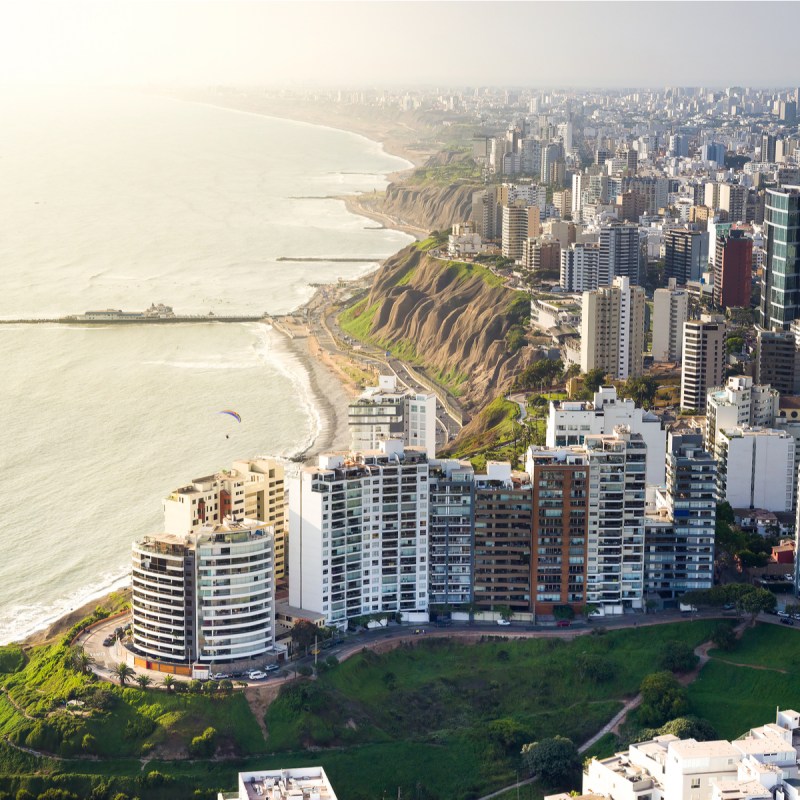
Lima, Peru, has been referred to as “The City Of Kings” because of its connection to Spanish royalty and because it was founded in 1535 by Juan Pizzaro on the Feast Day of the Three Kings. The origin of the city’s name is in dispute. One version has it derived from the Inca word “Limaq.” The Spanish had trouble pronouncing the final “Q,” so they dropped it, and Lima was born. Regardless of what the ancients called it, here are six sites to visit in this old and fascinating city, the capital of Peru.
Videos by TravelAwaits

1. Olive Park And 500-Year-Old Trees
Lima’s Olive Park may look like any other orchard or public green space, but it holds a secret to the character of the Peruvian people, the once-proud Inca empire, and the Spanish conquest of South America 500 years ago. That secret resides in about two dozen olive trees.
In the San Isidro neighborhood on the south side of Lima, the Bosque el Olivar, several dozen gnarled olive trees bent by history and the Peruvian wind represent not only the values and perspective of the Peruvian people, but they point to their resilience as well. Beginning in 1532, Spanish conquistadors began taking over Inca land in what is today Peru. In that conquest, more than 7 million people died. The Spaniards did something else, though, something beneficial. They planted many hundreds of olive trees.
Though the Spanish conquerors are long gone, the trees they planted are not. The trees in the picture date from the mid-16th century. The history of these 500-year-old trees is fascinating, simply because of their age. When Spaniards sailed west from Seville in the 16th century, they carried several olive trees with them. Only three of those trees survived the ocean crossing. But those three trees propagated more than 3,000 others, several of which are in Lima’s park of olives today. They’re protected by the Peruvian government, so the only thing visitors can take from them are pictures. And yes, they still produce olives!
Pro Tip: Visiting Olive Park is a low exertion level. While walking through this idyllic park, you’ll likely see one or more of the yellow-vested “Serenazgos,” the sentries who volunteer their time to enforce the protections of the ancient trees. The sentries enjoy chatting visitors up, though their English skills are minimal. The park is also a place for residents to congregate, where kids play in fountains, and musicians serenade the neighborhood almost every night. The park is 24 acres and well patrolled.

2. San Isidro Has Numerous Attractions
Another attraction in Lima’s San Isidro neighborhood — and a fairly easy walk from Olive Park — is the Huaca Huallamarca, the so-called Pan de Azucar or the “sugar bread loaf,” which resembles a loaf of bread. This pyramid-shaped site contains burials dating to A.D. 200. The Huaca in the name has been roughly translated from the Quechuan word for “God.” The nearby museum has artifacts from Inca and some pre-Incan times, dating back almost 2,000 years.
Just west of Olive Park is the Lima Country Club. More than 100 years old, this golf club has a contentious history among everyday Peruvians due to its exclusivity.
Pro Tip: Exertion level at Huaca Huallamarca is moderate with some steep sections.

3. Coastal Lima And The Miraflores Neighborhood
Coastal Lima has every attraction tourists might need, from great shopping to an intensely colorful ocean walkway and the fine dining that’s made Peruvian food arguably the best in the world. The Miraflores neighborhood is considered the best place for tourists to stay in Lima. It’s close to beaches and oceanside amenities. While enjoying a beachside lunch at Larcomar, you’ll have a great view of the Pacific, with surfers catching waves and paragliders zipping by at one of the best sites in Peru to pursue this sport. As for swimming and similar water activity, Lima’s beaches tend to be rocky, and not heavily visited. Speaking of Larcomar, this cliffside mall offers some of the best shopping boutiques and dining in Lima.
Pro Tip: Since Miraflores is very popular with tourists, it’s also a magnet for those who take advantage of tourists. Wear backpacks in front, leave the Rolex at home, and don’t flash wads of money around. Violent crime is unheard of, but petty theft is not. Several fine hotels and Airbnbs are available, but since the area caters to expats and tourists, expect somewhat high prices there. Larcomar has numerous name-brand boutiques and restaurants that Asian, American, and European travelers will recognize.

4. Barranco Means Nightlife And Dining
Located on the Pacific Coast between Chorillos and Miraflores neighborhood, Barranco is arguably the best place in Lima to stay, especially if nightlife, music, and ceviche are your reason for the visit. Restaurants abound here, such as El Muelle, La Canta Rana, and Isolina, a family-style restaurant once voted one of the top 50 restaurants in South America.
Close by is Lima’s answer to Venice, Italy’s famous Bridge of Sighs. Lima’s Puente de Los Suspiros is relatively new. Built in 1876 to allow fishermen access to their boats, Lima’s Bridge of Sighs is considered the most romantic spot in Lima and is a legendary courting spot for young lovers and poets. Unlike the bridge in Venice, which elicited sighs of despair from condemned prisoners who crossed it, Lima’s bridge elicits the breathless devotion of lovers. One legend has it that anyone seeing the bridge for the first time gets one wish if they’re able to cross it without taking a breath.
Pro Tip: Barranco has several hostels and small hotels as well, and is easy to get to by taxi from anywhere in Lima. The Moovit app comes in handy with navigation as Lima’s bus system is confusing and somewhat chaotic.

5. Museo Rafael Larco Hoyle Museum For Pre-Columbian Artifacts
The museum’s founder, Rafael Larco Hoyle, studied the cultures and customs of ancient Peru and was responsible for excavating archaeological sites on the country’s north coast. Larco Hoyle is considered the father of Peruvian archaeology. The Larco Museum near Colmenares has one of the biggest collections of Pre-Columbian artifacts in South America.

The radiating piece shown above, for example, is a sort of abacus used to track various transactions, like grain harvests, etc. In the annex to the museum, the clay pottery offers a perspective on Pre-Columbian peoples’ apparent ease with physical pleasures. Indeed, one wing of this museum contains numerous clay figures that suggest sex was simply an enjoyable and wholly sanctioned activity with no shame attached.
References are made to the difficulty presented when the Spanish priests learned of this indulgence, and how bewildered the Inca people were at this strange reaction.

6. Fine Dining In Lima Is Worth A Visit By Itself
With respect to Peruvian food, anyone visiting the City of Kings can eat like royalty. With arguably the best food and presentation in the world, Peruvian cuisine is tantalizing, innovative, and delicious. The home of ceviche, raw fish soaked in various tasty marinades, famous pisco sours, and possibly the best mojitos ever imbibed, there are several must-visit restaurants in Lima.
Our favorite is Astrid y Gastón, which offers one of those dining experiences that goes far beyond simple nutrition. Lunch or dinner at Astrid is an event. Afterward, you’ll recommend it to fellow travelers for its delightful menu, exquisite presentations, perhaps the best pisco sour ever to pass your lips, and clever dessert selections like the chocolate bomb dessert.
For seafood, and very nearly in the sea, La Rosa Nautica can’t be beat. La Rosa is located at the end of a pier, and you’ll watch surfers that seem close enough to touch while savoring seafood that may have been caught outside the window. La Rosa Nautica may have the best view of any coastal restaurant in Lima.
For vegan and vegetarian options as well a full-service menu, Huaca Pucllana is excellent. The view there is of the ancient ruins of Huaca Huallamarca, and the decor of Huaca Pucllana reflects its proximity to that site.
Lima — the City of Kings — is one of those places that can be a destination all its own. But
Lima is also the jumping-off point for such sites as Cusco, nearby Machu Picchu, and Nazca with its famous geoglyphic lines that have defied explanation for many years. But Lima, the City of Kings beckons anyone wishing to explore Pre-Columbian artifacts, fall in love on a bridge, celebrate ancient olive trees, or dine like royalty.
For more ideas and inspiration on a trip to Peru, check out these articles:
